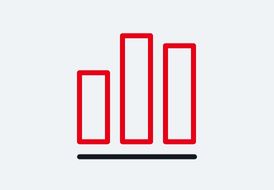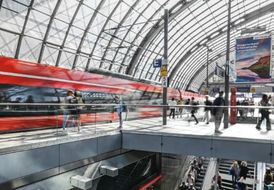Conserving resources
Use of materials in track infrastructure | 2022 | 2021 | 2020 |
Ballast (thousand t) | 3,471 | 3,638 | 3,186 |
Share of recycling (%) | 11.4 | 10.7 | 16.2 |
Machine ballast processing (million t) | 1.3 | 1.3 | 1.5 |
thereof directly recycled | 0.6 | 0.7 | 0.7 |
Concrete ties (thousand) | 2,089 | 2,590 | 2,400 |
Share of recycling (%) | 13.3 | 10.4 | 10.0 |
Period: October 1 to September 30.
For the maintenance of the track network, we have established a material cycle for ballast and concrete ties:
- In 2022, around 3.1 million t (previous year: 2.8 million t) of worn-out ballast was removed from the track network and reprocessed in certified disposal facilities into recycled ballast for internal reuse or further use as gravel or crushed sand for road building. As part of our maintenance measures, some of the ballast is processed on-site by track-bound ballast cleaning machines or mobile processing plants, and immediately reused. This significantly reduces the amount of new ballast required and the associated transport-related greenhouse gas emissions.
- In 2022, around 533,000 t of unusable concrete ties were removed (previous year: 535,000 t). The concrete ties are, where feasible, reworked for reuse in the track network. Concrete ties that are not suitable for this are recycled by certified disposal companies and used for other applications, such as road or path construction.
- We use reusable dishes in our restaurants, the DB catering service and in DB Lounges. We also operate a deposit return system. Returnable glasses are used for small snacks. With our partner RECUP’s deposit system, we offer 100% recyclable plastic cups and trays from low-energy production. RECUP and REBOWL were awarded the German eco-recognition “Blauer Engel” (Blue Angel).
- Through the use of innovative 3D printing procedures we are contributing to efficient and resource-saving component production. In particular, this means that components that in the worst case could result in train downtimes can be manufactured at the touch of a button. Since 2015, we have printed over 80,000 (replacement) parts in more than 500 different applications.
- The use of HVO means we do not have to prematurely discard functional diesel trains and locomotives that are currently still being used on non-electrified lines. They can continue to be used until the end of their useful life in a much more climate-friendly way than before.
- DB start-up encore manufactures storage from old lithium-ion batteries from e-vehicles. These second-life battery storage systems can store energy from solar, wind or hydroelectric power and can therefore be used for up to ten years depending on the use case. By reusing old batteries and extending their service life, encore requires fewer primary raw materials such as lithium, nickel or cobalt, which makes a valuable contribution to resource conservation. The first of these battery storage systems was put into operation on the EUREF campus in Berlin in July 2022.


